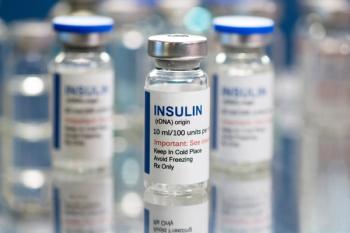
Glucometers Help Patients Manage Diabetes
Pharmacists can offer important counseling points on the appropriate use of the devices to monitor blood glucose levels at home.
Glucometers play an important role in helping patients with diabetes manage the disease, as these devices track blood glucose fluctuations. There are a variety of glucometers available, with basic to advanced features.1 Pharmacists can educate patients about glucometers, providing instructions on appropriate use, for instance.
2019 DIABETES GUIDELINES: TECHNOLOGY
For the first time, the American Diabetes Association added a special section on diabetes technology to its updated guidelines.2 The guidelines emphasize that diabetes technology is continually expanding and includes devices that both deliver insulin and monitor blood glucose. Self-monitoring of blood glucose (SMBG) is extremely important, especially for patients using intensive insulin therapy (figure).2 Intensive insulin regimens are defined as multiple daily injections or insulin pump therapy.2 The guidelines discuss a lack of evidence regarding how often SMBG is needed for patients who are not using intensive insulin regimens or who receive oral therapies.2 Patients using basal insulin should check their fasting glucose with SMBG to help achieve targets. Studies have questioned the routine use of SMBG in patients using oral medications.2 However, SMBG can provide useful information on the effects of diet and exercise on target goals and assess for hypoglycemia. The following are glycemic goals for patients with diabetes: glycated hemoglobin, <7%; fasting blood glucose, 80-130 mg/dL; and postpran- dial blood glucose, <180 mg/dL.3
NEW STUDY ASSESSES GLUCOMETER ACCURACY
A recent study assessed the accuracy of 18 glucometers marketed in the United States, with the assessment comprising about 90% of all available devices from 2013 to 2015 that were cleared by the FDA.4 The study included 1035 participants tested at 3 study sites, and the passing standard was considered within 15% or 15 mg/dL of the laboratory value. Participants were 18 years and older with no instances of diabetes, prediabetes, type 1 diabetes, or type 2 diabetes. The study found that just 6 of the 18 glucometers passed: Accu-Chek Aviva Plus, Accu-Chek SmartView, Contour Next, CVS Health Advanced, FreeStyle Lite, and Walmart ReliOn Confirm (Micro).4 Furthermore, this study can play a key role in counseling patients on the selection of a glucometer.
COUNSELING POINTS
In an interview with Pharmacy Times®, Andrea Levin, PharmD, BCACP, assistant professor in the Department of Pharmacy Practice at Nova Southeastern University College of Pharmacy in Davie, Florida, discussed important counseling points for glucometers. She emphasized the importance of checking strips to ensure that they have not expired and that patients should program the correct times into the glucometer. Also, individuals taking medications, such as insulin, that can cause hypoglycemia should have their glucometers with them at all times. Levin added that patients should not leave glucometers in a car because extreme heat can affect their efficacy. She also recommended using control solution periodically to ensure that a glucometer is working properly.
Patients should check with their insurance providers to determine coverage details for glucometers. Cost can vary, and some insurers limit coverage to specific models or place limits on the total number of test strips allowed.1 The Diabetes Forecast Consumer Guide provides information about most of the glucometers on the market.5 The guide includes details on the blood drop size needed, cost, manufacturer contact information, and technology features.5 Glucometers also have special features, which may be helpful depending on the patient’s needs. These may include easy-to-handle and large test strips, as well as illuminated screens and audio, useful for individuals with impaired vision.1 Pharmacists should advise patients to not purchase or resell used test strips, which can give inaccurate results.2
Patients should be counseled about the signs and symptoms of hypoglycemia, which include confusion, nervousness, shakiness, sleepiness, and sweating. Patients experiencing these symptoms should check their blood glucose levels immediately. Hypoglycemia is considered blood glucose <70 mg/dL and should be treated with 15 g of carbohydrates (eg, glucose tablets, juice).3 Individuals should check their blood glucose again after 15 minutes of treatment, and if it is still <70 mg/dL, they should have another 15-g serving of carbohydrates.
Jennifer Gershman, PharmD, CPh, is a drug information pharmacist and Pharmacy Times contributor who resides in south Florida.
REFERENCES
- Blood glucose meter: how to choose. Mayo Clinic website. mayoclinic.org/ diseases-conditions/diabetes/in-depth/blood-glucose-meter/art-20046335. Published December 17, 2016. Accessed January 20, 2019.
- American Diabetes Association. 7. Diabetes technology: Standards of Medical Care in Diabetes-2019. Diabetes Care. 2019;42(suppl 1):S71-S80. doi: 10.2337/dc19-S007.
- American Diabetes Association. 6. Glycemic targets: Standards of Medical Care in Diabetes-2019. Diabetes Care. 2019;42(suppl 1):S61-S70. doi: 10.2337/dc19-S006.
- Klonoff DC, Parkes JL, Kovatchev BP, et al. Investigation of the accuracy of 18 marketed blood glucose monitors. Diabetes Care. 2018;41(8):1681-1688. doi: 10.2337/dc17-1960.
- American Diabetes Association. Blood glucose meters. Diabetes Forecast website. main.diabetes.org/dforg/pdfs/2018/2018-cg-blood-glucose-meters.pdf. Accessed January 20, 2019.
Newsletter
Stay informed on drug updates, treatment guidelines, and pharmacy practice trends—subscribe to Pharmacy Times for weekly clinical insights.










































































































































































































